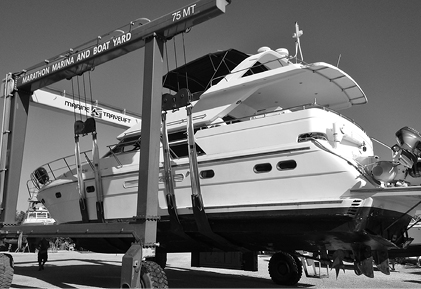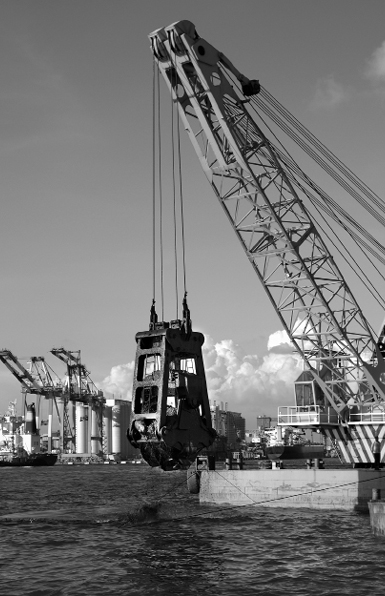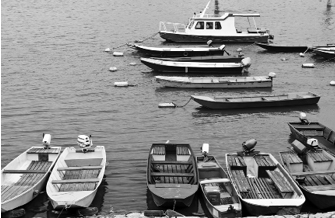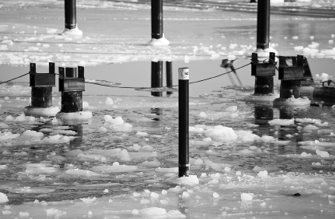
Marina Facilities – Important Issues

Safety and Security
General Safety
Basic security awareness is all about knowing your surroundings. If a marina is adjacent to dangerous urban neighborhoods or commercial port facilities, common sense should be the number one deterrent to being victimized. Lighting on your vessel, on the docks, in parking lots and other shore-side facilities (laundry, bathrooms, etc.) also is essential for prevention of theft and vandalism.
It is always best to have your vessel berthed near a few other live-aboard vessels where neighbors can keep an eye on your property during your absence. If you know them reasonably well, inform them of your schedule for departure and return, so that if they notice anyone aboard your vessel they’ll know its reason for concern and action.
Thieves by Sea
Shore-side security is foremost on people’s mind but boaters must also look in the other direction. Namely, that thieves can and do approach from the water. Theft of an automobile from a parking lot with gated security is much more difficult than coming alongside a vessel in darkness to steal onboard items.
In recent years, many marinas have experienced robbery of floating dinghies and launches tied to their mother vessel or adjacent pier. Owners of small vessels do not need these ‘tenders’ or ‘chase boats’ but most vessels above 50 feet in length have dinghies that are convenient for running to shore when the large vessel is anchored out. Normally the dinghies are lifted aboard with a davit or lifting boom then tied down. In this position they are mostly inaccessible by thieves but when large vessels are berthed in a marina or at-anchor in a harbor, the dinghy is often left floating alongside. Some carefree crew tie a couple lines from the dingy to the pier or vessel and all is well — until a thief notices the prospective floating prey. For the thief, it’s easy to quietly come alongside in a rowed skiff or kayak, cut two small lines with a knife and tow the dinghy and outboard away. Definitely a small effort to steal a 12-foot rigid inflatable boat, onboard electronics and forty-horsepower, four-stroke outboard, all worth about $30,000. Some larger dinghies and launches have replacement values approaching $100,000.
|
AUTHOR RECOMMENDATION |
|
Whenever your dinghy is afloat during the night, attach it and its outboard to your vessel with a heavy chain and lock. Keep it well lit and consider a security system or something as simple and inexpensive as a sound monitor like those commonly used in household rooms while babies are sleeping. Waking to voices around your dinghy will give you time and options to deter the thieves. |
There’s one more thing to worry about with regard to thieves approaching by water. If your dinghy has a large, expensive outboard, experienced marine thieves can easily unbolt the lower unit of the engine without need for the entire engine to be removed from the dinghy transom. Recently, there have been many lower units stolen from expensive outboards in South Florida, some worth $5,000 each. Five minutes work with a few hand tools and the job is done. If you must leave your motor on the transom of a floating dinghy, lock the motor in the ‘down’ position because thieves don’t like working underwater in the dark.
It’s most important to review your vessel insurance policy regarding theft overall and dinghies specifically. Some basic policies exclude dinghies; a rider (add-on policy) must be purchased in such cases. Interestingly, some dinghy policies do not cover the loss of a dinghy if it’s being towed, stating that the owner is negligent if the towline is parted. Read the fine print.
Fire Prevention

All vessels must have fire extinguishers onboard that satisfy U.S. Coast Guard requirements, as well as those specified by the vessel insurance policy. However, marinas also are required to have fire prevention equipment on the docks. Most have portable fire extinguishers that can be carried aboard vessels if onboard extinguishers have been fully discharged. Some marinas have fire hoses coiled on vertical stands for use in the event of local fire. Boaters should become familiar with all fire extinguishing systems provided by the marina, whether they are located on the docks or within other buildings of the facility.

When fires occur aboard boats in marinas, neighboring boats are often involved and very quickly. If you are onboard your vessel when fire starts on another vessel in the marina, it is recommended that you immediately move your vessel away from the dock until all fire is extinguished. There is no other way to guarantee that your vessel will not become involved in the fire.
Marina Personnel for Dockside Assistance
Especially for operators of large vessels, having a skilled line handler on the dock while entering or leaving a slip is a tremendous help and added safety for the vessel. Strong winds and currents can pose additional challenges when docking and having someone positioned dockside to tend spring lines is invaluable.
Line-handling assistance can be obtained from boaters of adjacent slips but sometimes they’re not around when you need them. In these circumstances it’s helpful if the marina can provide a skilled line handler (commonly called a dock boy). At most facilities, docking assistance can be requested from the dockmaster’s office either before vessel departure or when entering the marina from sea or elsewhere, via a call using VHF radio.
Of course the ‘high-end’ marinas with extensive facilities, amenities and support staff have uniformed dock boys available full-time to assist with docking of tenant vessels. This certainly is a valuable service if you own a large vessel.
Boatyard for Haul-Out

Minor boat repairs can normally be conducted while your vessel remains in the water and tied to the dock, as long as the marina tenant agreement permits such maintenance. When major hull work is necessary (e.g., bottom painting or maintenance to through-hull valves, acoustic transducers, engine shafts, cutlass bearings, rudders or propellers), haul-out is typically planned in advance at a boatyard with full capabilities. Without a scheduled haul-out, vessels often have to wait weeks for service.
Emergency haul-out events are rare and normally are necessitated by significant leaks in through-hulls or around keels and running-gear components or caused by collision with rocks, other boats or docks. In such cases, it is ideal if your marina has capabilities to haul vessels of your size. Because yard management personnel know you as a marina tenant, they will usually put you first in line for that day to assure your vessel’s safety. Your gratitude will not be overlooked so extend it loudly. It also helps if you contract them to perform additional maintenance work while your vessel is ‘on the hard’ so they can realize additional revenue.
Compare this situation with one where you have no ‘pull’ at the only other boatyard in your vicinity. Good luck getting your boat out of the water quickly.
|
AUTHOR Recommendation |
|
If you have a chance to become a tenant at a good marina that also has an adjacent, working boatyard, sign up quickly. It’s one of the most valuable amenities you will encounter. |
Waste Disposal

Normal Trash
All marinas are responsible for removal of tenant wastes that are placed in well-marked trash containers situated on docks within a short distance of vessels. Recycling bins should be provided by the marina. However, at some poorly managed facilities, tenants are required to carry all trash up the pier to a large shore-based container (e.g., dumpster). If your slip is located far from the waste container, at least be aware of this when you sign the lease for your slip.
An opposite yet undesirable situation can occur if your slip is located near a large waste container. Odors can be offensive if the container is not emptied often so if a centralized dumpster would be located near your vessel, inquire about the frequency of its emptying. Also note that at some facilities, dumpsters are emptied very early in the morning so you could be dealing with the sound of large waste collection trucks and loud beeping from their back-up sensors.
Become aware of these maintenance functions on your initial visit so they don’t surprise you later. If you determine there’s only one slip available when you visit a marina, there’s a high probability that all existing tenants know that slip has many disadvantages. Some boaters will initially accept the ‘bad’ slip to get their vessel into the marina but they’ll soon request to move when another, more-desirable slip becomes available. Remember that if you’re assigned the bad slip and you’re not a cooperative tenant, it’s likely you’ll be berthed there for years.
Oily Wastes
Vessel maintenance can often generate wastes that fall out of the general category of trash. For example, waste oil and engine coolant are typically changed annually and they must be disposed somewhere other than in the container designated for normal trash. The same goes for bilge water that can contain oil and coolant solutions.
Speak with the marina’s dockmaster to determine whether the facility has a permanent disposal container for oily wastes. If not, you had better locate a drop-off facility to dispose your oily wastes, presuming your volumes are small and easily transported. On the other hand, if your vessel generates many tens of gallons of oily waste, then it’s best to locate a local business (mobile truck or vessel pump-out service) that will come to your vessel for removal of the liquid waste. This topic of oily waste disposal is a very important matter for owners of large vessels. On-site containers provided by the marina are a significant benefit.
Large or Heavy Junk
A simple problem that’s easy to understand: most marinas do not allow tenants to place large (i.e., bigger than a suitcase) and/or heavy (i.e., greater than 30 pounds) items of trash in the container designated for normal trash. Boaters are therefore forced to remove these items from the marina facility or pay to have them taken away by a refuse hauling company. Suppliers of large appliances and beds will normally remove the replaced items following delivery of new goods, which fortunately solves the problem for this type of junk. Other more peculiar types of junk are often harder to get rid of. If you believe there is any recycle value (e.g., copper, lead or aluminum) in your junk item, ask the marina’s refuse hauling company if they would like to remove it for free.
Be creative and you might not have to pay for junk removal. Most people would be surprised how readily you can sell used marine items on Craigslist.com. For computer savvy folks, post anything you want to get rid of and someone might just call you up and pay to remove your junk.
Channel Access Restrictions
Marinas exist because boaters like to venture out to nearby waters or cruise to distant shores. There are however vessels that always stay tethered to the dock, either as home for live-aboard tenants, for future sale or if the vessel has passed its operational lifetime and the marina hasn’t yet evicted ‘her’. The majority of vessels that do venture out of the marina expect clear passage within navigable channels but there can be a few challenges, as identified below.
Dredging Interference

Channel deepening operations using mobile, floating dredges are normally accompanied by sediment transport barges and/or large pipes for pumping dredged sediment to nearby beaches or sediment disposal areas. Harbor Masters and U.S. Army Corps of Engineers (ACOE) project managers for the dredging operations normally assure that dredging equipment does not block channel passage but at times this cannot be prevented due to necessary equipment repositioning. The durations of these channel blockages are often short but there are cases when channels may be blocked for days or longer. If a major dredging project is underway near your marina, contact the on-site ACOE project trailer to inquire about potential channel blockage events if you must transit at a specific time.
Events
A different type of restriction on vessel passage can occur in some large urban harbors during times of boat shows. An example is when a large part of the harbor is consumed by floating docks, thereby restricting vessel movement in close proximity to the show area. A far worse case is when a marina forces all vessels (even long-term tenants) to move out for one to three weeks during a show. Although this might be written into their marina tenant agreement, it might not be mentioned the day you are signing the agreement. It sure can be a big surprise if a boater needs to seek an alternate marina location with only a couple days notice. Similarly, some marinas move their piers to accommodate pedestrian traffic at a show, thus preventing your vessel from leaving her slip for a week or two. Not a good situation if you don’t plan ahead.
The dates of major boat shows are known years in advance so consult with the marina office to determine if and how vessel navigation may be adversely affected if a show is planned in your vicinity.
Additional restrictions on vessel passage near your marina can be caused by holiday parades, major sail races, swimming or kayaking events, passage of U.S. Government military vessels, etc.
Handicap Access

All marinas must abide by city ordinances for handicap access but this primarily pertains to shore-based facilities (e.g., bathrooms, showers, laundry, etc.). Normally it’s the boat owner’s responsibility to provide safe and convenient vessel access for handicapped persons invited aboard. Ramps and steps from the pier to the vessel can generally accommodate this.
The biggest handicap challenge at a marina can be associated with the ramp used for access from shore to the piers. If the marina has a large tidal range, at times of low tide or especially during a Spring tide event, the primary ramps must accommodate a drop of 10 feet or more. This steepness is difficult to maneuver even for people with full capabilities. For those with limited mobility or confinement to a wheel chair, the vertical climb or descent is near impossible. Further, many ramps with handrails are too narrow to accommodate conventional wheel chairs regardless of the ramp’s angle from the horizontal.
|
AUTHOR RECOMMENDATION |
|
If you expect to have handicapped persons visit your vessel, be sure to assess the marina’s access ramps and gain familiarity with any extreme tidal characteristics of the harbor so that you plan around times of greatest ramp steepness. |
Dinghy Storage

This too sounds like a simple topic but sometimes not. Vessels berthed in marinas often keep their dinghies on deck to prevent biofouling of their hull, galvanic corrosion to the outboard motor and theft. At times however, dinghies are used for local fishing, touring the harbor or happy hour visits at other facilities; consequently they’re often kept in the water for a few days. The best situation for temporary, in-water dinghy storage is adjacent to the primary vessel — either tied alongside or off the transom to facilitate easy access and boarding. Many slips provide sufficient space for this type of temporary tie-up but be sure the dockmaster and your tenant agreement permit such practices.
The worst case is a marina that specifies all dinghies must be kept in a designated area, typically some (inconvenient) distance from your vessel. They may even charge a fee for this in-water dinghy storage so beware.
|
AUTHOR RECOMMENDATION |
|
Inquire with marina management (or dockmaster); view where other tenants tie their dinghies when in the water; and carefully read the tenant agreement and associated pricing structure. |

Boat Launching Ramp
This guidebook primarily addresses marina use by vessels that are sufficiently large that they’re not regularly hauled out of the water on trailers that back into the water via paved ramps. Consequently, having a boat launching ramp at your marina is typically not essential. If however, you wish to haul your dinghy for storage or repair on land, having a nearby ramp for use with a trailer is a major convenience versus having to move your large vessel to a loading dock and lifting with your davit or crane. The dockmaster will know the whereabouts of the nearest launching ramp.
Cable TV Service
Most marinas provide the option for cable TV service on each pier via a coaxial cable connector on the pedestal providing AC power and water to your slip. Typically there is one commercial cable provider so there isn’t much to negotiate, except the package you wish to subscribe to, at the quoted price. In some cases, cable TV is included in the price of slip rental.
Some marina cable lines provide, at no charge, local channels from analog TV stations but these have very limited service; typically one channel for local news and ten others with TV shows from the fifties (e.g., Lassie, Andy Griffith, Gilligan’s Island, etc.). Seek other options including subscribing to a satellite dish network or installing one of the relatively inexpensive indoor or outdoor digital antennae for capturing local HD TV channels. It is recommended that you consult with a local communications expert to assess options for TV reception on your vessel when berthed at the marina.
Wi-Fi Service
It wasn’t many years ago that Wi-Fi was new and established solely for shore-based applications. Fortunately, Wi-Fi service has become another utility that marina owners should provide to boating tenants in order to be competitive. When the technology was new, most marinas would make a half-hearted (low cost) attempt to provide Wi-Fi service to their tenants via a single Wi-Fi antenna mounted on the roof of the marina office. To no surprise, Wi-Fi signal strength, data transmission speed and connectivity were poor except for tenant vessels located very close to the single antenna. Now, most progressive marinas make a greater effort to provide good Wi-Fi service, often installing multiple Wi-Fi antennae at different locations around their facility to guarantee reliability on all piers.
|
AUTHOR RECOMMENDATION |
|
As you are walking around the marina speaking to any long-term residents, ask them about the Wi-Fi coverage at their pier then ask if they’ve heard of connectivity problems at other locations in the marina. Just because they might have gotten lucky in their slip doesn’t guarantee that other piers have any coverage. If possible, try to determine where any Wi-Fi shadow zones exist before you finalize your slip selection. |
If you need high bandwidth Wi-Fi for business use while aboard your vessel, consider subscribing to an independent commercial Wi-Fi service in the event the marina’s free Wi-Fi does not meet your throughput needs.
Postal and Package Delivery

Most marinas that accommodate live-aboard tenants offer mailboxes or at least a delivery point for mail and packages. Some have good mail security (e.g., individual boxes and locked mail facilities after hours) while others handle everything as general delivery and everyone can go through the entire mail pile daily. At these facilities, delivery of important mail or valuable packages is highly discouraged.
Boaters who do not wish to worry about security of their incoming mail should rent a mailbox at the local U.S. Post Office or a private mail/shipping company.
Ship’s Store

Most full-service marinas have a Ship’s Store for purchase of boating hardware, fishing gear, beverages, take-out food items and minor produce. Some also have fresh and frozen bait for your fishing needs. If you are evaluating two marinas and one has a store open seven days per week, it’ll prove to be a major convenience.
Seasonal Considerations

Marinas at mid- and high latitudes normally have seasonal occupancy, with some totally closed and piers removed from the harbor during months of severe storms and likely harbor icing; certainly not the time for a visual marina assessment. At lower latitudes the busy season is during winter when northerners travel south for warm weather and calmer seas than are typical for their homeland. If possible, try to assess marina facilities during maximum occupancy to evaluate tenant congestion, competition for vehicle parking and other marina amenities. Some facilities appear adequate on either side of the ‘high season’ but parking can be prohibitive during peak occupancy.